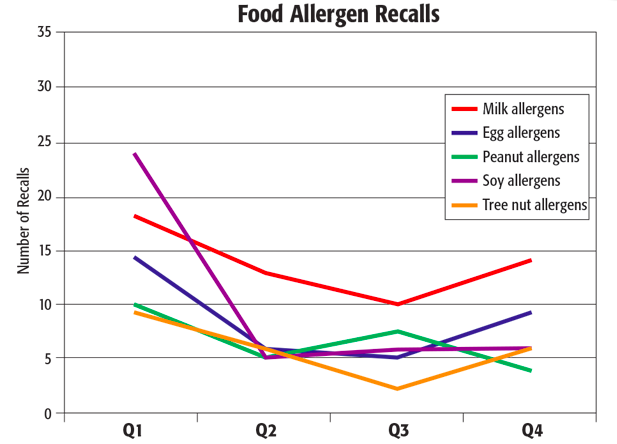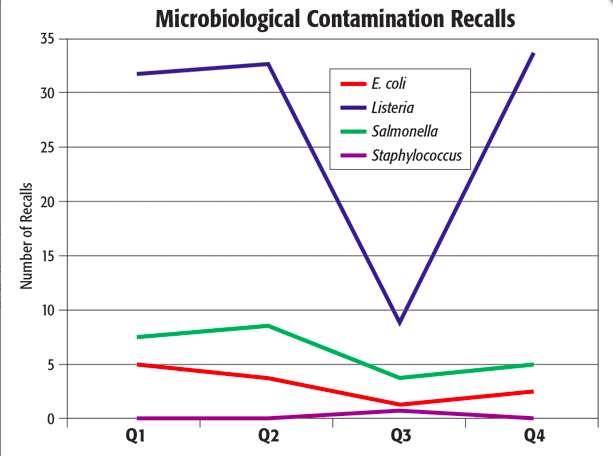By Tiffany Maberry
To say that 2018 was quite a year for food safety would be an understatement. For many different reasons, food product recalls and outbreaks seemed to never cease over the past year. For the fourth consecutive year, Food Safety Magazine has kept track of every food-related recall announced by the U.S. Food and Drug Administration (FDA), as well as the U.S. Department of Agriculture Food Safety and Inspection Service (USDA FSIS). As usual, we make no claims that our tally includes every single recall that was issued—it’s always possible that some may have fallen through the cracks. Still, we believe the following synopsis provides a fairly accurate overview regarding what’s happening—and not happening—with food in the U.S.
For 2018, we counted a total of 382 food product recalls. Some products were recalled more than once and that usually occurs when additional product variations, lot numbers, or retail locations are identified. Also, as we’ve noted in previous years, a single product can be recalled for more than one reason, say, two different types of microbial contamination in the same product.
Undeclared Allergens
Last year, we recorded 160 product recalls due to undeclared allergens. About one-third of these were due to
undeclared milk.
1. Milk – 55
2. Tree nuts – 39
3. Eggs – 33
4. Peanut – 26
5. Soy – 24
6. Wheat – 19
Although sometimes these recalls occur due to unintended cross-contamination, that’s not the only reason why these recalls occur. Commonly mentioned in recall notices is that the actual problem is product mislabeling. So even if a food product is formulated perfectly, it can still be recalled if the label does not disclose whatever allergenic ingredients may possibly be present in that food product.

Listeria, Salmonella, and Escherichia coli
Seventy food products in the U.S. were recalled due to possible Listeria contamination in 2018. Most of these products were pet foods, followed by (mostly soft) cheese products and then various meats. The positive news here is that the number of Listeria-related recalls appears to have dropped significantly since the previous year (108 in 2017).
Salmonella was suspected in approximately 67 recalls last year, mostly related to pet foods, followed by ready-to-eat deli salads and wraps.
E. coli was named in 16 food recalls, mostly for raw ground beef products.

Foreign Material Contamination
Out of 28 foreign material contamination recalls in 2018, about half of them (13) were caused by the presence of plastic. The second-most common foreign material that prompted multiple food recalls was metal.
What Happened with Pet Food
In analyzing all of last year’s recalls, it could not be ignored that it wasn’t a great year for U.S. consumers who feed packaged goods to their beloved dogs and cats. Pet food recalls involving microbiological contamination were rampant throughout the year. These were primarily due to Salmonella and Listeria—sometimes both in the same product—in addition to E. coli although on a lesser scale. But it didn’t end there. There was a seemingly sudden handful of recalls associated with elevated levels of vitamin D, which can be toxic. According to FDA, while vitamin D is an essential nutrient for dogs, too much of it can cause kidney failure or even death. At least one of the pet food manufacturers that issued a recall blames a “formulation error” for their product quality issues.[1,2]
Outbreaks Galore
While the focus of this annual feature is meant to hone in on food recalls, we could not move forward without mention of some of last year’s food-related outbreak cases.
Let Us Talk About Lettuce
Needless to say, 2018’s dominant food safety topic was leafy greens, specifically romaine lettuce. First, 2018 started with an E. coli O157:H7 outbreak that carried over from 2017. This outbreak, which first became apparent in November 2017, occurred simultaneously in both the U.S. and Canada. By the time that year ended, the outbreak—believed but never confirmed (in the U.S) to be linked to romaine lettuce—had sickened at least 17 people in 13 states. Canada, however, did pinpoint romaine lettuce as the source of their E. coli outbreak and issued a warning to citizens to avoid the leafy greens until the outbreak appeared to be over. More than 40 illnesses across Canada were reported.[3]
Up next was the romaine lettuce outbreak that, after an investigation, was determined to be from the Yuma, AZ, growing region. According to the U.S. Centers for Disease Control and Prevention (CDC)’s final outbreak update in June, 210 people in 36 states were infected with E. coli O157:H7 in this outbreak, 96 people were hospitalized, and 5 people died. Based on laboratory testing results, investigators discovered that the same outbreak strain that sickened all the victims was also present in Yuma growing region canal water. As of January 2019, it’s been reported that the canal in question will be drained to better pinpoint the cause and source of the contaminated water. Investigators believe that once the canal is drained and completely dried, crews will then be allowed to go in and remove sediment where the E. coli bacteria may have colonized.[4,5]
Finally, a third E. coli outbreak linked to romaine lettuce gained national attention in November was determined to be from a farm in Santa Maria (Santa Barbara County), CA, which is part of the Central Coastal growing region of northern and central California. By the time CDC declared the outbreak over last month, 62 people had fallen ill in 16 states and Washington D.C., and 25 people had to be hospitalized. During the investigation, the E. coli O157:H7 strain was found in sediment collected within an agricultural water reservoir at the Santa Maria farm.[6,7]
A New Precedent for Listeria in Meat
Since 2003, there had not been an illness or fatality linked to a Listeria-contaminated meat product in the U.S. That changed in 2018 when Johnston County Hams in Smithfield, NC recalled more than 89,000 pounds of ready-to-eat ham products that may have been contaminated with Listeria monocytogenes. The outbreak was first brought to light after one listeriosis patient was confirmed in late September. The outbreak led to a total of four illnesses—all requiring hospitalization—in two states. One person died.[8,9]
Bad Eggs
Approximately 206,749,248 eggs produced by Rose Acre Farms were recalled in April due to a Salmonella scare. The eggs were sold under multiple brand names including Walmart’s Great Value and Publix. The eggs were also sold to many restaurants. A total of 45 illnesses were reported in 10 states. Eleven people had to be hospitalized. All of the victims reported eating eggs or egg-containing dishes. When the Hyde County, NC, farm was inspected, FDA found samples that contained the same strain of Salmonella Braenderup that caused the 45 illnesses. The massive recall was prompted by multiple reports of illness on the East Coast. Rose Acre Farm produces 2.3 million eggs per day.[10]
JBS Tolleson
Between October and December of 2018, JBS Tolleson, Inc. (Tolleson, AZ) recalled a whopping 12 million pounds of raw ground beef products that may have been contaminated with Salmonella Newport. The list of affected products released by USDA is 18 pages long [11]. The meat products were sold primarily under the Kroger brand, both at the retail and foodservice levels in Texas, California, Arizona, Virginia, Kentucky, Indiana, and Michigan. Epidemiologic, laboratory, and traceback evidence indicates that ground beef produced by JBS Tolleson was a likely source of this outbreak. CDC’s last update published in December indicates that the multistate outbreak infected 333 people in 28 states. Ninety-one people had to be hospitalized.[12]
Cargill
In September, Fort Morgan, CO-based Cargill Meat Solutions issued a recall of 132,000 pounds of ground beef products made from the chuck portion of the carcass that had been packaged on one specific date in June 2018. The meat, which was shipped to retailers nationwide, was believed to be the cause of a multistate E. coli outbreak. CDC reports a total of 18 illnesses in four states. Six people had to be hospitalized, and unfortunately, one person lost their life.[13,14]
FDA Exercises Mandatory Recall Authority
Since gaining new authority under the Food Safety Modernization Act (FSMA), FDA issued its first-ever mandatory recall of a food product last April. All food products containing kratom powder that was manufactured, processed, packed, or held by Triangle Pharmanaturals LLC were recalled after testing revealed positive Salmonella findings. The mandatory action was deemed necessary after the company failed to cooperate with FDA’s initial requests to issue a voluntary recall. Under FSMA, FDA has the authority to order the recall of certain food products when the agency determines that there is a reasonable probability that the article of food is adulterated or in violation of certain allergen,
labeling requirements and that the use of or exposure to such article will cause serious adverse health consequences or death to humans or animals.[15]
Is There Any Good News?
From a consumer perspective, it may seem that the U.S. food supply isn’t so safe. However, the food industry knows quite well that food products grown, produced, and manufactured within the U.S. is among the safest in the world.
The CDC’s official list of foodborne outbreaks for 2018 includes 24 of them—more than any year for which CDC’s website shows a record. The outbreak lists go back to 2006.[16]
In November, CNN quoted FDA Commissioner Scott Gottlieb’s remarks about the recent persistence of food-related recalls. “I think that the issue isn’t that there’s more unsafe food. I think what’s happening is that we have better technology than ever before to link outbreaks of human illness to a common pathogen.”[17]
Does this mean that, in the coming year, we can expect to see the number of recalls and outbreaks continue to climb? Only time will tell.
1. https://www.fda.gov/animalveterinary/newsevents/ucm627485.htm.
2. https://www.fda.gov/Safety/Recalls/ucm625016.htm.
3. https://www.foodsafetymagazine.com/news/similar-e-coli-outbreaks-persist-in-us-and-canada/.
4. https://www.cdc.gov/ecoli/2018/o157h7-04-18/index.html.
6. https://www.cdc.gov/ecoli/2018/o157h7-11-18/index.html.
7. https://www.fda.gov/downloads/Food/RecallsOutbreaksEmergencies/Outbreaks/UCM631271.pdf.
8. https://www.cdc.gov/listeria/outbreaks/countryham-10-18/index.htm.
10. https://www.fda.gov/Safety/Recalls/ucm604640.htm.
12. https://www.cdc.gov/salmonella/newport-10-18/index.html.
13. https://www.cdc.gov/ecoli/2018/o26-09-18/index.html.
15. https://www.fda.gov/NewsEvents/Newsroom/PressAnnouncements/ucm603517.htm.
16. https://www.cdc.gov/foodsafety/outbreaks/multistate-outbreaks/outbreaks-list.html.
17. https://www.cnn.com/2018/11/20/health/romaine-lettuce-e-coli-cdc/index.html.

